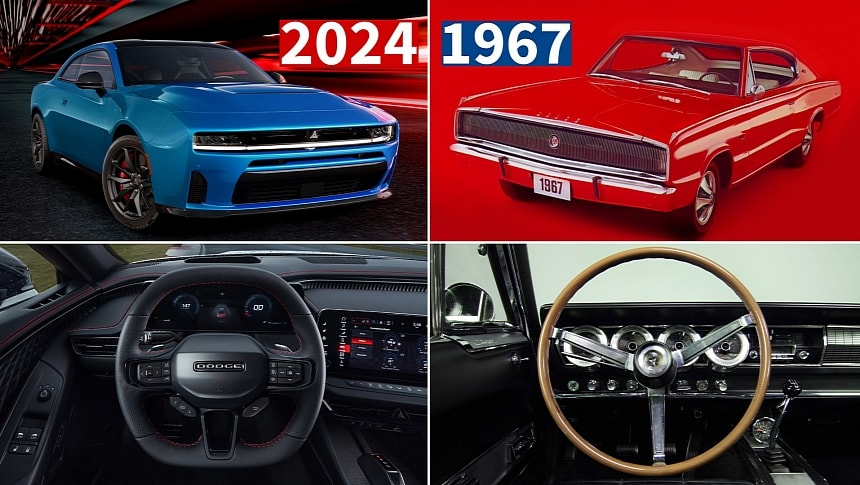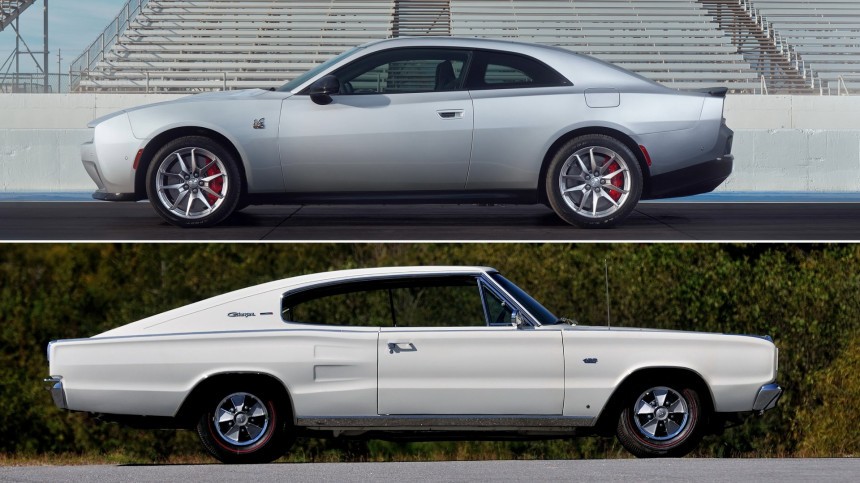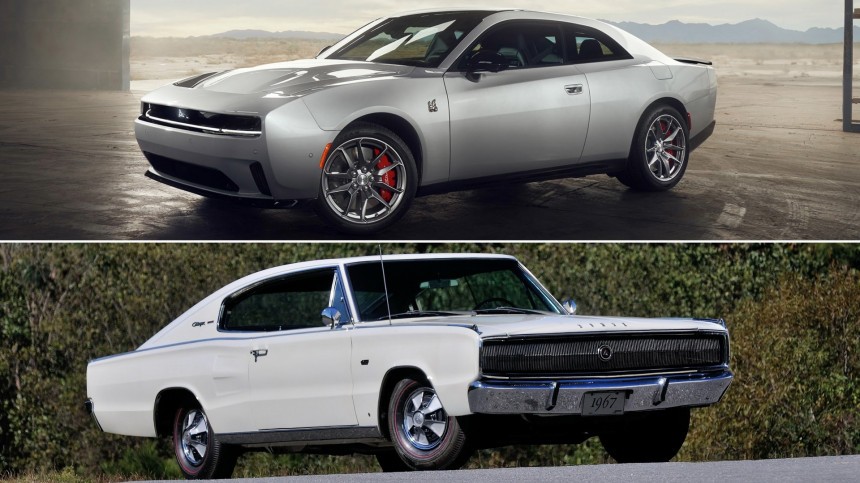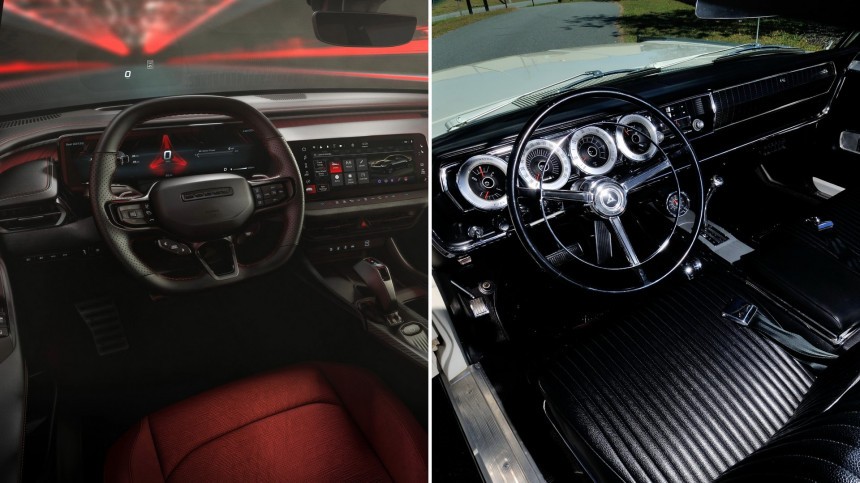After the unveiling of the all-new 2024 Dodge Charger, we’re left with a whole bunch of questions that weren’t addressed by the carmaker during the presentation. Some are technical in nature, while others are all about the design.
The all-new Charger is Dodge’s first multi-energy muscle car, so to speak. It’s built on the STLA Large platform, capable of carrying vast amounts of power, including from battery-electric drivetrains. For example, the all-electric AWD Charger Daytona gets a 400V propulsion system combining for as much as 670 horsepower.
Personally, I’m sure the new Charger is a real hoot to drive, and I’m sure it’s fast – with even faster variants probably still to come. What I’m not so sure about is the styling, at least to some extent.
This is how Dodge sees it: “The all-new Dodge Charger presents a distillation of muscle car design through a modern muscular exterior that focuses on function, avoids excess and subtly acknowledges inspiration from the clean, timeless lines of its predecessors.”
My problem with that official statement is the exterior doesn’t really look all that muscular to begin with. The new car certainly doesn’t look as aggressive as the Challenger, nor does it cast as big a shadow as the classic Charger, or rather the second-generation Charger.
Speaking of which, this feature story was originally going to be about the second-gen Charger, seeing as how it’s the most iconic iteration, with the best design. Basically, we would have compared the 2024 Charger’s styling with that of the 1968 through 1970 model. So, why didn’t we?
Well, for starters the second-gen Charger was redesigned for the 1968 model year to feature coke bottle styling, meaning both the front and rear fenders were curvier, and the rear-end itself was more sedan-like, rather than a fastback, from a visual standpoint. The same cannot be said about the all-new 2024 model, which has very subtle curves, and it basically looks like a fastback, especially with that gigantic rear pillar.
2024 vs. 1967: Profile
If you’re going to compare the all-new Charger (in Coupe form) with any other classic Charger, it should be the first-generation model. It’s the only one that features similarly angular lines, a thick sweeping rear pillar, a full-width taillight panel and fastback styling.
Basically, we’re dealing with a similar design philosophy, although I doubt Dodge took much inspiration from any classic Charger. Yes, bits and pieces here and there, but the new Charger is clearly more of a mix between the outgoing 4-door model and something that has a completely new look, albeit one that’s still identifiable.
I also think Dodge might have drawn up the all-new 2025 Charger sedan before they figured out they could turn it into a 2-door variant. Why do I think this? Because the proportions of the Charger sedan fit the overall shape and size of the vehicle, whereas the Coupe feels a bit forced – there's way too much space left from the doors to the rear wheels and pillars.
Anyway, if we’re talking spiritual successor, at least visually, I think it’s definitely the first-gen Charger we should be discussing in relation to this all-new model. I’m no automotive designer, but the second-gen car, as popular as it was, simply doesn’t have much in common with the new product. Feel free to disagree though.
2024 vs. 1967: ¾ Front
From this angle, you could make a case for the new car giving off some second-gen Charger vibes, but again, it’s nowhere near as sleek as the latter. Besides, the rectangular front-end styling is also reminiscent of the original car, which actually wears the very badge that Dodge decided to reimplement on this newest iteration.
Granted, that’s where the similarities end. Again, if we take a big step back and look at the design of the all-new Charger as a whole, it’s hard to associate it with anything other than a sleeker but more watered-down version of the 2023 Charger. It almost looks too unassuming, or not sufficiently aggressive.
Maybe they’ll find ways to improve it, like with a factory-standard widebody kit, although if we take the Challenger for example, it looks epic even without the flared fenders.
Conspiracy theory alert: Maybe Dodge intentionally under-designed the all-new Charger so as to increase the value of the 2023 Challenger and Charger on the used car market. Just kidding, they most certainly didn’t do that, but you can’t tell me that you’d rather have next year’s Charger Coupe in 550 hp SIXPACK H.O form, as opposed to a used Challenger with pretty much any Hellcat-derived specification.
I’m sure the new twin turbocharged 3.0-liter straight-six Hurricane engine is a beast, but it’s no supercharged Hemi V8. Let’s be real.
2024 vs 1967: Interior
It just dawned on me that Dodge missed a heck of an opportunity to use that “new” badge in the middle of the steering wheel too, like you see on the original car. Instead, it just says ‘Dodge’. At least get creative with it – use ‘SRT’ like you did with the Hellcat specifications.
In terms of interior design, there’s no commonality between the original car and the 2024 one. What the new interior does remind me of, to some extent, is the C8 Corvette’s cabin, especially that upper part of the dashboard and how the screens are angled towards the driver. It feels sort of like a mix between the Camaro and the Corvette’s dashboard, even though it shouldn’t - totally different carmakers.
Still, there are plenty of features and functions to like when it comes to the all-new Charger’s interior. You’ve got the immersive new Attitude Adjustment ambient lighting system with 64 colors (it reacts to vehicle events), the available 16-inch cluster screen with a 12.3-inch center display, an optional augmented head-up display, and even the sound characteristics.
Check this out: the new Charger Daytona (the electric variant) features something called a Fratzonic Chambered Exhaust, which uses two passive radiators to create an exhaust note with “Hellcat levels of sound intensity”. There’s also a stealth sound mode, but it’s interesting to know that you can make your all-electric Charger sound like a futuristic muscle car at the touch of a button.
Which decision? Well, the one where they completely exited the conventional large sedan and muscle car segments, to focus on battery electric power. For starters, EV sales are slowing down across the board, and for the life of me I can’t figure out why they simply couldn’t design a car that looked every bit as aggressive as the 2023 Charger/Challenger duo.
With that in mind, I doubt they’d design the exact same car they just unveiled, if they had to do it all over again (knowing what they know now).
Personally, I’m sure the new Charger is a real hoot to drive, and I’m sure it’s fast – with even faster variants probably still to come. What I’m not so sure about is the styling, at least to some extent.
This is how Dodge sees it: “The all-new Dodge Charger presents a distillation of muscle car design through a modern muscular exterior that focuses on function, avoids excess and subtly acknowledges inspiration from the clean, timeless lines of its predecessors.”
My problem with that official statement is the exterior doesn’t really look all that muscular to begin with. The new car certainly doesn’t look as aggressive as the Challenger, nor does it cast as big a shadow as the classic Charger, or rather the second-generation Charger.
Speaking of which, this feature story was originally going to be about the second-gen Charger, seeing as how it’s the most iconic iteration, with the best design. Basically, we would have compared the 2024 Charger’s styling with that of the 1968 through 1970 model. So, why didn’t we?
Well, for starters the second-gen Charger was redesigned for the 1968 model year to feature coke bottle styling, meaning both the front and rear fenders were curvier, and the rear-end itself was more sedan-like, rather than a fastback, from a visual standpoint. The same cannot be said about the all-new 2024 model, which has very subtle curves, and it basically looks like a fastback, especially with that gigantic rear pillar.
2024 vs. 1967: Profile
Basically, we’re dealing with a similar design philosophy, although I doubt Dodge took much inspiration from any classic Charger. Yes, bits and pieces here and there, but the new Charger is clearly more of a mix between the outgoing 4-door model and something that has a completely new look, albeit one that’s still identifiable.
I also think Dodge might have drawn up the all-new 2025 Charger sedan before they figured out they could turn it into a 2-door variant. Why do I think this? Because the proportions of the Charger sedan fit the overall shape and size of the vehicle, whereas the Coupe feels a bit forced – there's way too much space left from the doors to the rear wheels and pillars.
Anyway, if we’re talking spiritual successor, at least visually, I think it’s definitely the first-gen Charger we should be discussing in relation to this all-new model. I’m no automotive designer, but the second-gen car, as popular as it was, simply doesn’t have much in common with the new product. Feel free to disagree though.
2024 vs. 1967: ¾ Front
Granted, that’s where the similarities end. Again, if we take a big step back and look at the design of the all-new Charger as a whole, it’s hard to associate it with anything other than a sleeker but more watered-down version of the 2023 Charger. It almost looks too unassuming, or not sufficiently aggressive.
Maybe they’ll find ways to improve it, like with a factory-standard widebody kit, although if we take the Challenger for example, it looks epic even without the flared fenders.
Conspiracy theory alert: Maybe Dodge intentionally under-designed the all-new Charger so as to increase the value of the 2023 Challenger and Charger on the used car market. Just kidding, they most certainly didn’t do that, but you can’t tell me that you’d rather have next year’s Charger Coupe in 550 hp SIXPACK H.O form, as opposed to a used Challenger with pretty much any Hellcat-derived specification.
I’m sure the new twin turbocharged 3.0-liter straight-six Hurricane engine is a beast, but it’s no supercharged Hemi V8. Let’s be real.
2024 vs 1967: Interior
In terms of interior design, there’s no commonality between the original car and the 2024 one. What the new interior does remind me of, to some extent, is the C8 Corvette’s cabin, especially that upper part of the dashboard and how the screens are angled towards the driver. It feels sort of like a mix between the Camaro and the Corvette’s dashboard, even though it shouldn’t - totally different carmakers.
Still, there are plenty of features and functions to like when it comes to the all-new Charger’s interior. You’ve got the immersive new Attitude Adjustment ambient lighting system with 64 colors (it reacts to vehicle events), the available 16-inch cluster screen with a 12.3-inch center display, an optional augmented head-up display, and even the sound characteristics.
Check this out: the new Charger Daytona (the electric variant) features something called a Fratzonic Chambered Exhaust, which uses two passive radiators to create an exhaust note with “Hellcat levels of sound intensity”. There’s also a stealth sound mode, but it’s interesting to know that you can make your all-electric Charger sound like a futuristic muscle car at the touch of a button.
Hot Take
Seeing as how the all-electric Charger has been in development for years, I can’t help but wonder if the carmaker would make the same decision now as it did back then.Which decision? Well, the one where they completely exited the conventional large sedan and muscle car segments, to focus on battery electric power. For starters, EV sales are slowing down across the board, and for the life of me I can’t figure out why they simply couldn’t design a car that looked every bit as aggressive as the 2023 Charger/Challenger duo.
With that in mind, I doubt they’d design the exact same car they just unveiled, if they had to do it all over again (knowing what they know now).





















